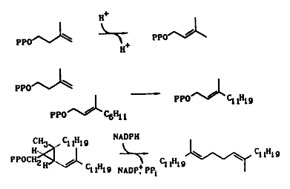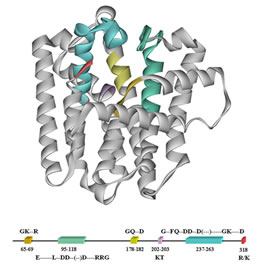My research group is interested in problems at the interface between organic chemistry and biochemistry. We study reactions catalyzed by enzymes in the isoprene biosynthetic pathway with special emphasis on establishing the mechanisms of the enzyme-catalyzed transformations and how the enzymes promote the reactions.

We also study structure-function relationships in peptides and proteins to determine how the particular topology of a complex biological molecule is related to its function as a catalyst or a ligand for receptor binding.
The isoprene biosynthetic pathway is needed by all organisms to produce essential compounds. We are studying several key enzymes in the pathway that catalyze fundamental reactions, including the isomerization of isopentenyl diphosphate (IPP) to dimethylallyl diphosphate (DMAPP), the condensation of IPP with a variety of allylic diphosphates to yield new allylic isoprenylogues containing five additional carbons, the unusual rearrangement of presqualence diphosphate (PSPP) to squalene during biosynthesis of cholesterol, and the posttranslational modifications of proteins by isoprenoid units that are important in cell signalling events. We are also studying unusual isoprenoid alkylations that occur during biosynthesis of ergot alkaloids, post-translational modifications of proteins, and in transfer RNAs.
We are isolating genes for the enzymes we study, construct plasmids for overexpression of the enzymes, and carrying out side-directed mutagenesis on critical amino acids to elucidate their role in catalysis. All of the reactions presented above are interesting biological alkylations in that they do not rely on commonly observed carbonyl group chemistry for construction of carbon-carbon and carbon--heteroatom bonds.Work in this area provides training in a combination of biochemical (purification of enzymes, kinetics, precursor-product studies) and chemical (synthesis, isolation-identification, reaction mechanisms) techniques.

Much of what we do relies heavily on modern analytical methods such as high pressure liquid chromatography, high field multinuclear magnetic resonance spectroscopy, and gas chromatography-mass spectrometry. We draw on ideas and techniques from organic chemistry and biochemistry to design our experiments, including developing new procedures for synthesis of compounds, developing new methods for measuring interactions between an enzyme and its substrates, and using recombinant DNA technology to obtain biological molecules that are normally difficult to isolate. It is the interdisciplinary nature of our work that we find both challenging and exciting.
